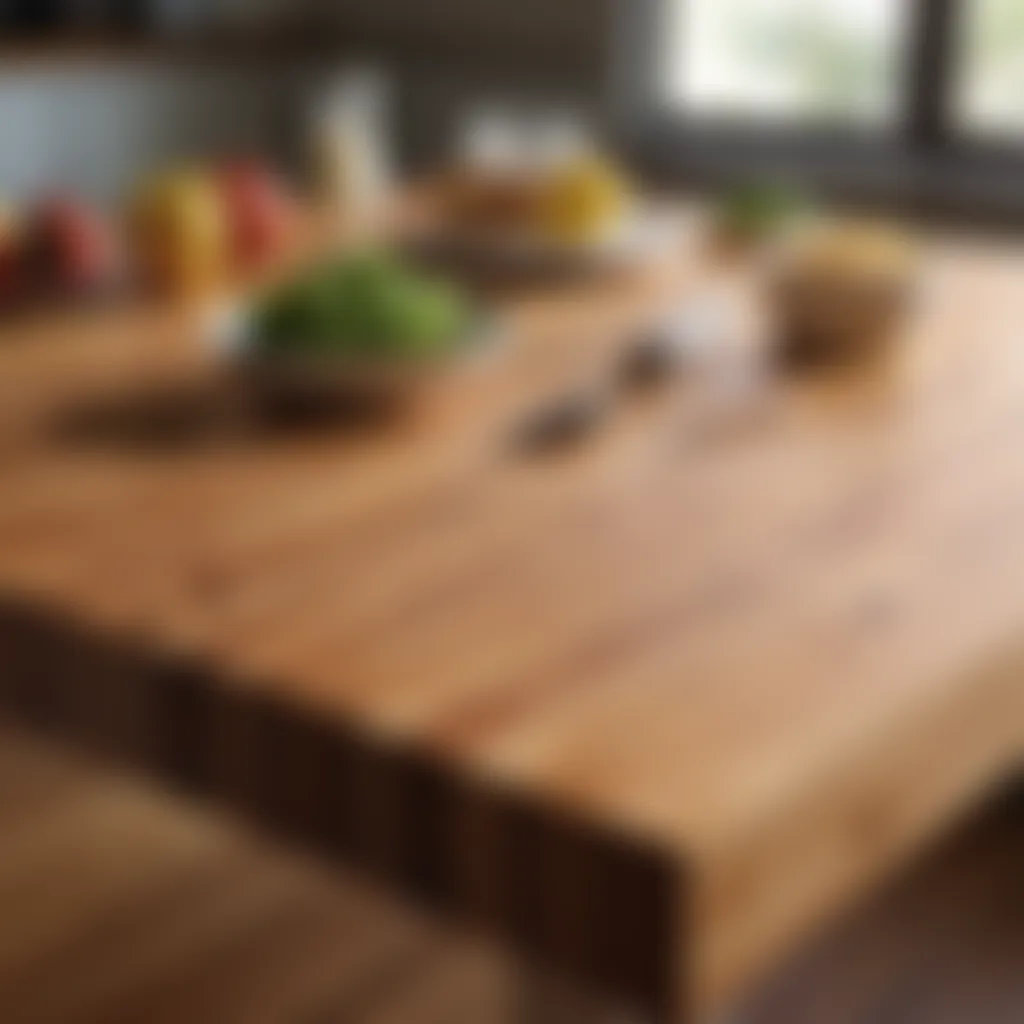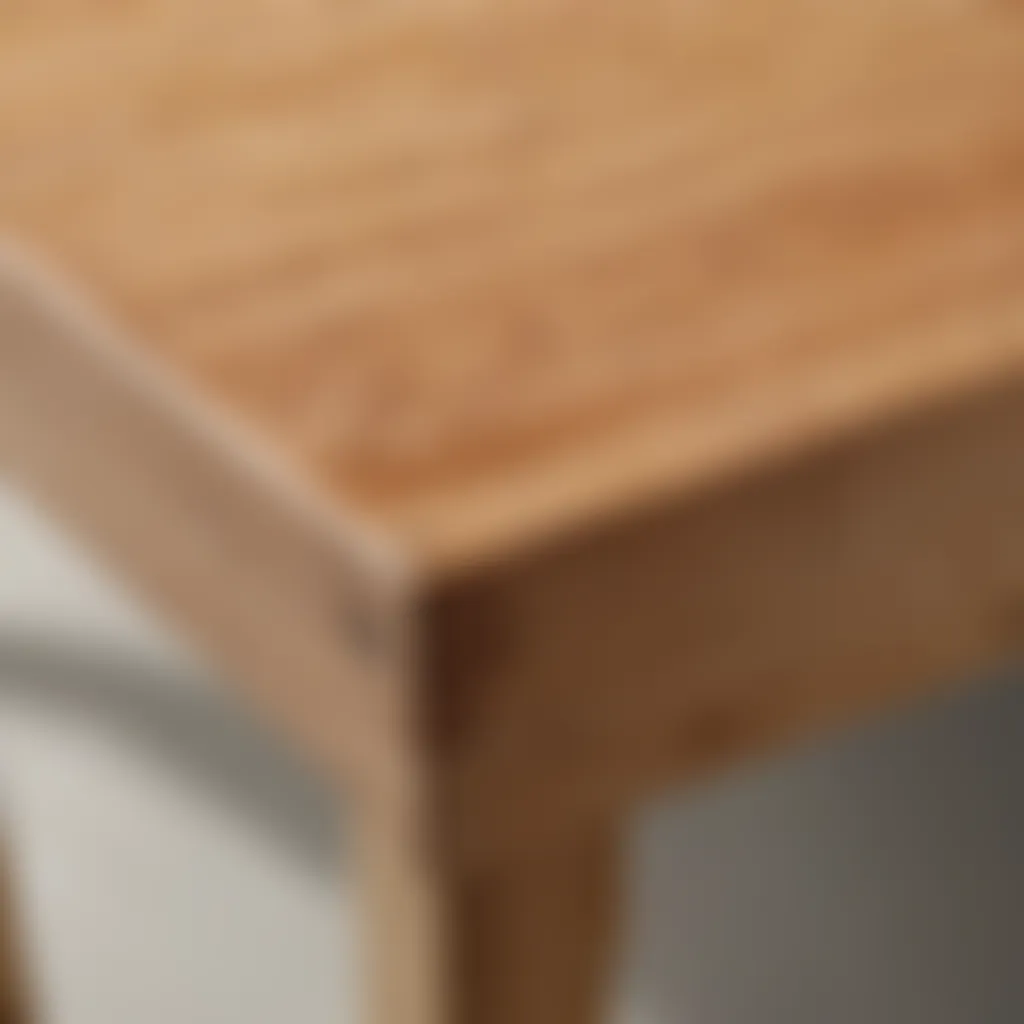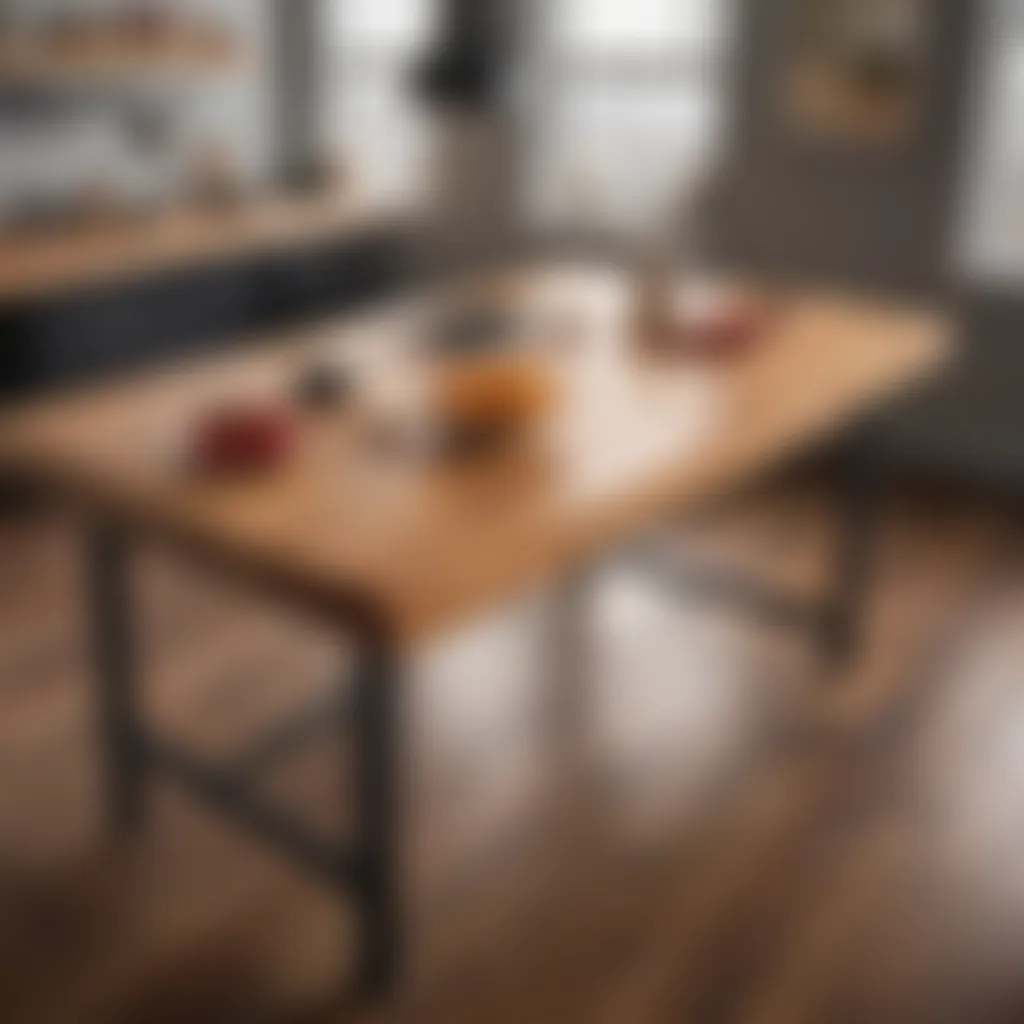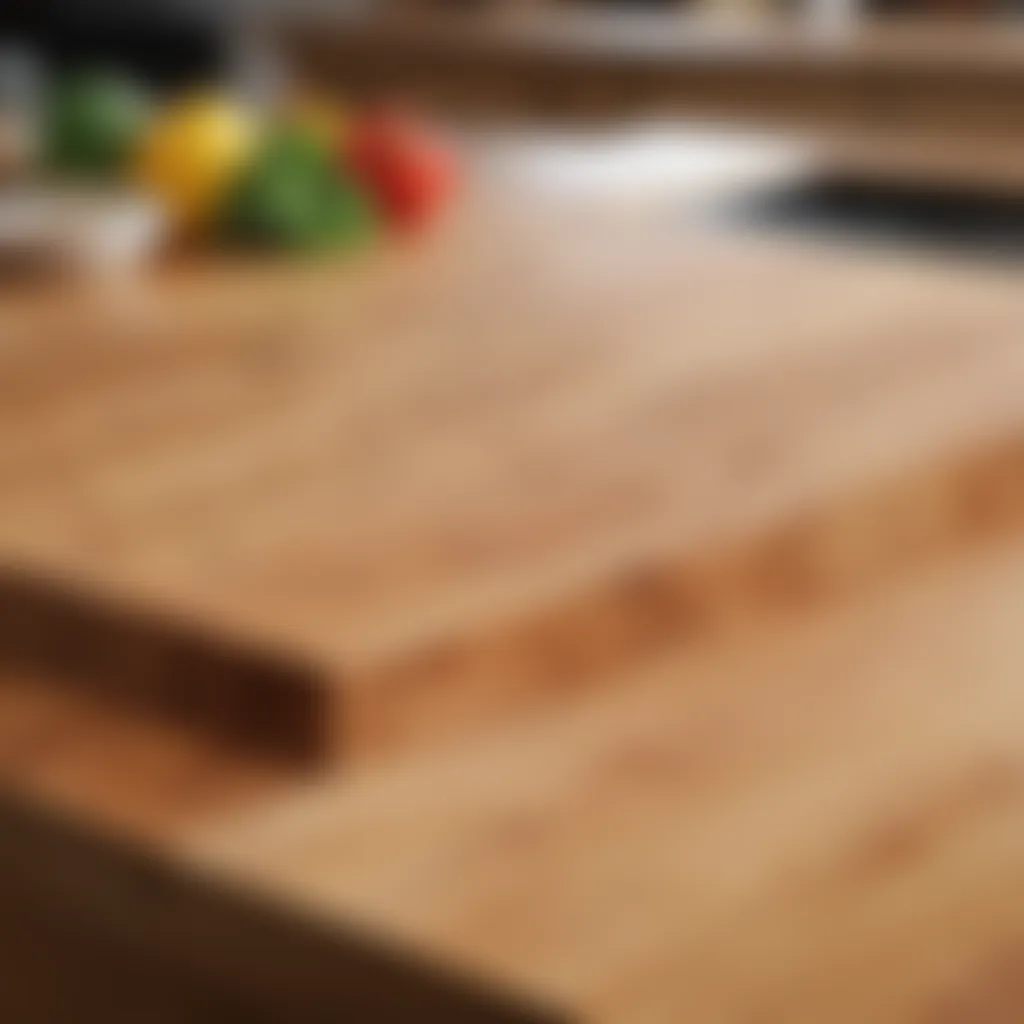Exploring the Versatility of Butcher Block Desk Tops


Preface
Butcher block desk tops have become a staple in numerous environments, from home offices to high-end workplaces. Their unique blend of functionality and aesthetic appeal makes them a standout choice. This article aims to peel back the onion on these versatile surfaces, examining their construction, benefits, and care, while shedding light on the sustainability aspects associated with wooden materials.
Ingredients:
- Hardwood Species: Oak, Maple, or Walnut (choose based on personal preference)
- Adhesives: Food-safe PVA glue for strength and durability
- Mineral Oil: To treat and condition the surface over time
- Sandpaper: Various grits from coarse to fine
- Clamps: To hold wood in place during construction
- Safety Gear: Gloves, goggles for protection during sanding
Detailed Instructions:
Preparation Steps:
- Select Your Wood: Choose hardwood species for durability and beauty. Maple has a lighter hue, while walnut offers a rich, dark finish.
- Measure and Cut: Prepare wood pieces according to desired dimensions of the butcher block top. Ensure all edges are straight for a seamless fit.
- Glue the Joints: Apply food-safe adhesive to the edges of the wood pieces. Press them together firmly and use clamps to hold in place while drying.
- Sand the Surface: Once dry, start with coarse sandpaper and gradually move to finer grits to achieve a smooth finish.
Technical Aspects:
- Temperature Settings: Ensure your workspace is at room temperature to allow adhesives to cure properly.
- Timing Specifics: Allow glue to dry for at least 8 hours before unclamping. Sanding may take a few hours depending on the surface area.
Cooking Process:
- Apply Finish: Once sanding is complete, clean the surface and apply mineral oil generously, letting it soak in for several hours.
- Cure the Top: Allow the surface to sit overnight for complete absorption before using it.
Troubleshooting Tips:
- If the surface feels rough after sanding, repeat with a finer grit sandpaper.
- For sticky spots from the glue, a mixture of vinegar and water can help clean the area without damaging the wood.
Importance of Butcher Block Desk Tops:
"Choosing the right butcher block desk top is not just about wood type or color, it's about creating a workspace that inspires creativity and productivity."
Butcher block tops are not only about style; they bring unmatched utility to your workspace. Understanding how to care for and maintain these surfaces enhances their longevity, making them a wise investment for any housewife keen on style and function.
Understanding Butcher Block Desk Tops
Grasping the essence of butcher block desk tops is crucial for anyone considering the integration of these surfaces into their workspace. The practice transcends mere aesthetic choices; it’s about functionality, sustainability, and the long-lasting value of wood. This section paves the way to understanding why butcher block materials are not only a popular choice but also a wise investment for both home and professional environments.
Definition and Overview
Butcher block desk tops are crafted from thick, laminated wood sections that are bonded to form a dense, flat surface. Their primary purpose stems from their initial use in kitchens, where they served as sturdy surfaces for cutting and preparing food.
The beauty of a butcher block lies in its simplicity and versatility. Often made from various wood species, these tops offer a warm, inviting aesthetic that can complement numerous decor styles—from rustic farmhouse to sleek contemporary. What sets butcher block apart is its unique ability to blend modern utility with timeless charm. As these surfaces gain traction beyond the kitchen, they emerge as central pieces in home offices and creative workspaces alike.
Historical Context
To fully appreciate the butcher block desk top, one must look back at its origins. First utilized by butchers in the 18th century, the heavy wooden slabs were designed to withstand the rigors of chopping and cutting, hence the name. The early effectiveness of these surfaces was rooted in practicality; the use of durable hardwoods ensured longevity, while the natural properties of wood helped to absorb impacts and shield delicate utensils.
As time passed, more homemakers began to admire the sturdy aesthetic that butcher blocks offered. By the 20th century, these surfaces found their way into kitchens and dining rooms, symbolizing craftsmanship and quality. As styles evolved, so too did their purpose. The modern era now showcases butcher block desk tops in various settings—embracing innovation by reimagining these historical pieces for functional workspaces.
In today’s context, the resurgence of interest in natural materials represents a broader trend towards sustainability and authenticity. As we move forward, understanding the blend of history and functionality in butcher block desk tops becomes essential for making informed decisions on interior design and furnishings.
Materials Used in Butcher Block Desk Tops
When it comes to butcher block desk tops, the choice of materials plays a crucial role. The right materials not only enhance the beauty but also determine the functionality and longevity of your workspace. Made primarily of wood, these desk tops offer a natural warmth and charm to any setting, making them a favored choice for both home and commercial spaces. Understanding the intricacies of materials, particularly the types of wood used and the construction techniques applied, is essential for making informed decisions.
Types of Wood
Hardwoods vs. Softwoods
Choosing between hardwoods and softwoods is much like choosing the right ingredient for a special dish; each brings its flavor and texture. Hardwoods, such as maple, oak, and cherry, are denser and more durable, making them better suited for high-traffic areas. They're less likely to dent or scratch, providing a stable surface that can withstand the rigors of daily use. Conversely, softwoods like pine or fir, while lighter and often less expensive, can be more prone to wear and tear over time.
A key characteristic of hardwoods is their resilience; they tend to resist damage better than their softer counterparts. However, this durability often comes with a heftier price tag and requires more effort to work with during the crafting process. On the flip side, softwoods, such as pine, are often more accessible and easier to shape, making them popular among DIY enthusiasts looking for a more budget-friendly option.
Hardwoods and softwoods each have their own unique attributes. For instance, while hardwoods like walnut boast rich color variations and stunning grain patterns, softwoods offer the ease of staining and finishing. Moreover, the choice between them typically boils down to the intended design and anticipated use—elegance or economy.
Popular Wood Choices


When it comes to popular wood choices for butcher block desk tops, hardwoods take center stage. Maple and walnut rank high thanks to their appealing aesthetics and ability to blend well with various design styles. Maple’s light and uniform grain can help brighten up a workspace, creating a refreshing atmosphere, while walnut is known for its rich, dark tones that add sophistication.
Another favorite is the oak. It is not only durable but also presents a unique grain pattern that adds character. The versatile nature of oak accommodates a range of finishes, enhancing its appeal for modern office setups as well as rustic environments.
The uniqueness of these woods lies in their performance and durability. While some may argue that hardwoods can be more costly, the long-term investment in quality can outweigh the initial expense. Budget-focused individuals might lean towards softer woods, but this often means a greater likelihood of damage in busy environments, which can lead to increased costs in maintenance or replacement down the line.
Construction Techniques
Glue Lamination
In the creation of butcher block desk tops, glue lamination stands out as a favored technique. This process involves bonding layers of wood together with strong adhesives to form a single, solid piece. Not only does this result in a surface that's less prone to warping, but it also allows for a wider variety of wood species to be combined, thus enhancing both durability and aesthetics.
A key advantage of glue lamination is its effectiveness in minimizing imperfections. The construction method creates a more stable piece, as moisture and environmental factors have less impact on the integrity of the wood. As a bonus, this technique can also be an environmentally friendly option when certified glues and sustainably sourced wood are used.
End Grain vs. Edge Grain
Choosing between end grain and edge grain construction is akin to selecting between two different cooking styles. End grain, which displays the wood’s cross-section, tends to be more forgiving on knives, making it a popular choice among chefs for cutting boards. However, on a desk top, it can be more challenging to maintain due to its porous nature, which may harbor stains and odors.
On the other hand, edge grain, visible in a more traditional butcher block look, provides a smoother, more uniform surface that's easier to keep clean. It’s often celebrated for its durability and resistance to daily wear. The choice between these two styles ultimately depends on preference and intended use; both offer distinct advantages, making them suitable for different applications depending on the aesthetic and functionality desired.
"The material choice not only influences the practical aspects of butcher block desk tops but also contributes significantly to the visual identity of the workspace."
Understanding the materials and construction techniques helps individuals select the right butcher block desk top that suits both functionality and style. With the blend of beauty and robustness in mind, the decision can elevate any workspace from mundane to marvelous.
Benefits of Butcher Block Desk Tops
When considering the intricacies of choosing a desk top, the benefits of butcher block surfaces stand out as compelling reasons to make one’s selection clear. From enhancing the visual appeal of a workspace to providing unmatched durability, butcher block desk tops present several advantages that cater to both aesthetic desires and long-term functionality.
Aesthetic Appeal
The charm of butcher block desk tops is undeniable. These surfaces bring a certain warmth and natural beauty that synthetic materials often lack. The grain patterns of different woods tell a story, offering a unique character to each piece. Imagine a workspace that not only serves as a functional area but also as a conversation starter. With a variety of woods, such as maple, walnut, or cherry, individuals can select a finish that complements their existing decor while enhancing the overall ambiance of the room.
- Natural Variation: Each butcher block has its own distinct look thanks to natural variations and imperfections, adding an artistic flair that machine-made materials simply cannot replicate.
- Versatile Styles: Whether the goal is a rustic farmhouse vibe or a sleek modern aesthetic, the versatility of butcher block allows it to fit seamlessly into various design themes.
- Customizable Finishes: Finishing options like oiling or staining can transform the appearance dramatically, offering flexibility depending on personal taste or seasonal decor changes.
Elegant and functional, butcher block desk tops are more than just surfaces; they are an integral part of a work environment that elevates productivity and creativity.
Durability and Longevity
Beyond aesthetics, durability is a pivotal factor to consider. Butcher block desk tops, when properly maintained, can withstand years of intensive use without compromising their structural integrity. Unlike some alternatives that may warp or chip over time, high-quality wood can endure significant wear.
Factors contributing to the durability include:
- Solid Construction: The method of construction, typically involving laminating strips of wood, enhances the durability of the surface, making it resistant to warping.
- Easy Repairs: Scratches and dents can be easily sanded down and refinished, which extends the lifespan considerably compared to plastics that would need replacement.
- Natural Resistance: Many hardwoods have a natural resistance to heat and moisture, making them suitable for a multitude of tasks, whether it’s writing, crafting, or even placing a warm coffee cup.
Good quality butcher block tops not only look great, they can also save you from the hassle of replacements down the line.
For those contemplating their workspace layout, understanding these fundamental benefits can vastly influence the decision-making process for selecting the right desk surface.
Applications of Butcher Block Desk Tops
Butcher block desk tops serve not just as a functional surface but also as a versatile design element that can enhance the aesthetic of any space. Their applications stretch beyond traditional use, touching various sectors immensely, from home environments to bustling commercial venues. Recognizing these applications allows an individual to appreciate the broader significance of butcher block in daily life, which includes its role in both style and utility.
In Home Offices
Creating a pleasant and efficient home office is no small task. The butcher block desk tops can play a pivotal role in transforming the mundane into the extraordinary. Their natural wood grain adds a touch of warmth and character that can uplift one’s mood, fostering a conducive environment for productivity. These surfaces are sturdy, ensuring that they can withstand the weight of multiple monitors or a stack of books without warping or losing their structure.
Moreover, the maintenance needs of butcher block tops are reasonably straightforward, making them practical for a home office setting. With minimal effort, one can keep the surface clean, and occasional oiling helps in preserving its charm. When considering size and shape, options abound to suit every space, from compact arrangements in cozy nooks to grand desktops that would stand out in larger rooms.
Commercial Uses
Restaurants and Cafés
For restaurants and cafés, the butcher block desk tops are much more than a mere surface for plates and drinks; they symbolize a commitment to quality, craftsmanship, and culinary tradition. The key characteristic of these tops lies in their ability to provide both a cutting-edge design and unmatched durability—perfect for establishments that value high foot traffic.
The unique feature of using butcher block in such environments is its inherent antibacterial properties when properly sealed, making it a safe choice for food preparation. Additionally, the aesthetic appeal adds a rustic charm, allowing establishments to create a welcoming atmosphere. However, occasional maintenance can't be overlooked. While these surfaces are built to last, spills and heavy use may require extra attention to keep them looking their best.
Workshops


In workshops, butcher block desk tops are a beloved choice among craftsmen and hobbyists alike. The significant aspect here is the heavy-duty nature of these surfaces that can endure rigorous activities from woodworking to crafting. The key characteristic of butcher block in this context is its robustness; it absorbs impacts and resists scratching, making it ideal for a workspace.
The unique feature of placing butcher block in workshops is not just its durability but also its versatile nature. Many artisans appreciate the smooth yet textured finish that allows for various tasks without much fuss. However, it is important to note that regular upkeep is necessary, as wood can wear down over time if not cared for properly. This diligent maintenance ensures that the work surface remains practical while retaining its beauty.
Design Considerations
Design considerations play a pivotal role in the selection and creation of butcher block desk tops. Unlike other surfaces, butcher blocks offer not just functionality but aesthetic appeal that can transform an ordinary workspace into an inviting one. When embarking on the journey to choose the right butcher block desk top, several specific elements are noteworthy. They influence not only the usability but also the visual tone of the environment.
Choosing Appropriate Size and Dimensions
When determining the dimensions of your butcher block desk top, you should think about both your space and the tasks you'll be performing. Too large, and it might overwhelm your room; too small, and you may find yourself cramped. Ideal dimensions can vary depending on personal needs but generally speaking, here’s what to consider:
- Height: Standard desk height is around 28 to 30 inches, allowing for comfortable seated work. However, if you're on the shorter or taller side, adjusting the height may be beneficial.
- Width and Length: These should complement the layout of your workspace. A width of at least 24 inches allows for comfortable writing or laptop use, while lengths can range from 48 to 72 inches depending on available space.
- Work Surface Area: Where materials will reside matters. Sufficient space is essential not only for your tools but also for the organization of your workspace.
Finishing Touches: Finish and Texture
The finish and texture of butcher block desk tops significantly enhance their appeal and functionality. A well-finished surface offers a unique blend of durability and beauty, making it a critical area of consideration. Several factors should be taken into account:
- Stain and Color Choices: You have various options for stain—think walnut, oak, or even a natural finish. The color can create warmth or a modern aesthetic. The stain should harmonize with existing decor while reflecting personal style.
- Surface Texture: This pertains to both feel and function. A smooth finish is functional for easy cleaning and a sleek look. However, textured finishes can add character and may even provide better grip for certain uses.
- Application of Protective Coatings: Beyond beauty, applying a food-safe mineral oil or a polyurethane finish increases the durability of the wood, protecting it from moisture and minor abrasions.
Design is about making choices that impact the experience, not just the look.
Sustainability Considerations
Sustainability has become a significant topic in modern design and furniture choices. Butcher block desk tops, often seen as utilitarian and stylish, play a pivotal role in addressing ecological concerns. Choosing a butcher block desk top is not just about the aesthetics or functionality; it's also about making a responsible decision concerning our planet's resources. Opting for these surfaces can yield both environmental and personal benefits, leading to a win-win situation for users and Mother Nature.
Source of Timber
In the heart of sustainability lies the choice of timber. Not all woods are created equal, and some have a more substantial environmental impact than others. The right sources of timber can significantly affect the ecological footprint of a butcher block desk top. For instance, selecting lumber from sustainably managed forests helps ensure that trees are harvested at a rate that allows for natural regeneration. This practice not only safeguards the forests' biodiversity but also supports local economies.
- Certification Matters: Look for woods that have been certified by organizations like the Forest Stewardship Council (FSC). This certification guarantees that the wood comes from forests that are environmentally sustainable, socially beneficial, and economically viable.
- Local Sourcing: Opting for locally sourced timber reduces transportation emissions, thereby minimizing the carbon footprint associated with your desk top. Plus, local businesses often have fewer resource-hungry shipping processes.
For instance, a cherry wood butcher block sourced from local farms can be less impactful than exotic woods shipped from halfway across the globe. The choice matters.
Eco-Friendly Treatments
While the wood you choose is crucial, how it's treated also contributes to sustainability. Eco-friendly treatments for butcher blocks can enhance longevity without compromising environmental integrity. Several techniques can provide protection while still being kind to nature.
- Natural Oils: Using natural oils like mineral oil or beeswax not only protects the wood but does so without introducing harmful chemicals. These oils nourish the wood fibers and create a moisture-resistant barrier that prolongs the life of your desk top.
- Plant-Based Finishes: Many manufacturers now offer finishes made from plant-based materials that are free from volatile organic compounds (VOCs). These finishes ensure minimal impact on indoor air quality, making your workspace healthier.
"Choosing eco-friendly treatments can extend the life of your butcher block while keeping harmful materials out of your home."
These approaches reflect a thoughtful engagement with sustainability, making your butcher block desk not just a practical choice, but a responsible one. Taking these steps means you're reducing your environmental impact while enhancing the beauty and functionality of your workspace. Moreover, when you share these practices with others, you can inspire conscious choices that create a ripple effect of positive change.
Maintaining Butcher Block Desk Tops
Maintaining butcher block desk tops is a vital part of ensuring their longevity and aesthetic appeal. These surfaces are not just functional items but also enhance the overall atmosphere of a workspace. With the right care, they can last generations, providing both utility and a rustic charm. It's essential to understand the importance of maintaining these surfaces, as neglect can lead to damage, undesirable stains, or other issues that can affect functionality. Plus, a well-maintained butcher block looks good and brings a sense of pride to those who use it.
Cleaning and Care Techniques
To keep your butcher block desk top in tip-top shape, daily cleaning rituals are necessary. It's a straightforward process, but one that involves a few specific steps to ensure the surface stays pristine. Here’s how to go about it:
- Use Mild Soap and Water: Avoid harsh chemicals that can strip the wood of its natural oils. A gentle soap diluted in warm water works wonders. Just take a soft cloth or a sponge and wipe down the surface.
- Avoid Soaking: Wooden tops absorb water like a sponge. Excessive moisture can lead to warping or splitting. Instead, dampen the cloth and make sure to dry the surface immediately after cleaning.
- Regular Sanitizing: Given that butcher block is often associated with food preparation, keeping it sanitary is crucial. A mixture of vinegar and water can do the trick. Simply spray the mixture, let it sit for a few minutes, and wipe it off. This helps eliminate bacteria without introducing harmful chemicals.
By adhering to these basic cleaning techniques, you can prevent debris and bacteria from taking permanent residence in your workspace.
Oiling and Treatment Regimens
Another key aspect of maintaining butcher block desk tops is regular oiling. This practice not only enhances the look of the wood but also provides a protective layer that keeps moisture out and prolongs the life of the wood. Here are some considerations:
- Choose the Right Oil: Look for food-safe mineral oils or specialized wood oils designed for butcher blocks. These options penetrate the wood finely, providing significant moisture resistance.
- Application Frequency: Oiling should be done regularly, ideally every month or whenever the wood appears dry. The frequency might vary depending on the environment, so keep an eye on how the wood looks.
- How to Oil: Pour a small amount of oil on a clean cloth and rub it into the surface. Follow the grain of the wood for even application. Let the oil sit for about 20–30 minutes and then wipe off any excess oil that hasn’t absorbed. This will prevent a sticky residue.
“A small investment in maintenance can yield significant returns in durability and beauty, turning a piece of wood into a cherished heirloom.”
Choosing the Right Butcher Block Desk Top
Choosing the appropriate butcher block desk top is more than just picking a surface to place your laptop on; it’s about understanding the unique blend of function and flair that these tops bring to a home or office. The right choice can enhance your workspace, making it not only practical but also visually appealing. This section delves into key points like personal needs, space considerations, and your budget, guiding you through the potentially overwhelming choices available in the market today.
Evaluating Personal Needs


Usage Patterns
Evaluating usage patterns is crucial to finding the right butcher block desk top. Individuals have varied workflows, and understanding these patterns can guide in selecting the ideal size and type of wood. For example, someone who works primarily with digital tools may not require a thick, heavy-duty surface, whereas a woodworker might opt for a robust variety. The key characteristic of usage patterns here is the distinction between static and dynamic—those who work more from fixed positions might prefer wider tops, while those who move around a lot could benefit from a tailored, compact solution.
A unique feature of considering usage patterns is how it plays into ergonomics. The right height and surface can prevent strain, allowing for long hours of productivity without discomfort. On the downside, a lack of understanding of personal workflows might result in choosing a desk top that’s either too small or unnecessarily large, leading to frustration down the road. In short, your day-to-day tasks greatly influence this decision.
Space Constraints
The size of your available workspace can significantly limit your options when selecting a butcher block desk top. Space constraints refer to how the dimensions of your area interact with the furniture you plan to introduce, including the desk itself and any surrounding elements. A crucial factor in this consideration is to measure your space accurately and visualize how the chosen piece will fit among existing furnishings.
What stands out with space constraints is the necessity to blend functionality with aesthetics. You may have a small nook that could serve as a workspace, which demands a compact yet stylish option. On the other hand, a sprawling home office allows for larger, more elaborate designs. Decisions about aesthetics become intertwined with practicality; ignoring the requirements of your space could result in cluttered chaos, both physically and visually, making the wrong choice either inconvenient or jarring to the eye.
Budget Considerations
When it comes to budget considerations, it’s essential to align your finances with the quality of materials desired. Butcher block desk tops can vary widely in price, influenced by wood type, finish, and craftsmanship. Spending your money wisely means balancing quality with your budget.
It can be tempting to skimp on costs, perhaps opting for cheaper woods or less treatment. However, investing in a more durable material upfront may save you money in the long run due to reduced maintenance and replacements. The sturdy nature of solid hardwoods makes them a favored choice, even if they come with a significant initial price tag.
In sum, understanding your financial constraints while also recognizing the long-term benefits of quality will lead you to a satisfying choice. A perfect butcher block desktop should reflect personal needs, fit the given space, and remain within budget—this trifecta will result in a productive and enjoyable workspace.
"An investment in a good desk top can elevate not only your work but also your environment, making every hour spent at your desk more fulfilling."
Challenges and Drawbacks
When delving into the world of butcher block desk tops, it's crucial to acknowledge that, like any material, they come with their own share of challenges and drawbacks. Farmers develop their skills over many seasons; similarly, those considering butcher block tops should develop an understanding of potential issues that can arise. These drawbacks may not be deal-breakers but certainly warrant consideration. They influence the usability, upkeep, and overall satisfaction with your purchase.
Potential Damage Issues
Butcher block desk tops are constructed from hard and soft woods, which can lend a certain charm to your workspace. However, one must fear the mighty enemy of all wooden surfaces: damage. Factors such as moisture, scratches, and even heat can wreak havoc on these beauties. For instance, placing a hot laptop or pot directly on the surface can lead to unsightly marks or, worse, warping. Water spills, when not swiftly addressed, can turn into larger headaches as they lead to swelling and can promote mold growth.
Consider watermark stains caused by mugs or glasses. They may seem trivial initially, but over time, these marks can pile up and make the desk look aged and tired. Additionally, maintaining a pristine look requires diligence in the form of regular maintenance and cleaning.
In dealing with these issues, prevention is often the best medicine:
- Use coasters or placemats to protect against heat and water damage.
- Regularly inspect your desk for scratches or dents, developing a habit of gently sanding down any problem areas.
Maintenance Requirements
Maintaining butcher block desk tops is akin to caring for a garden: it requires attention and sometimes elbow grease. Without proper maintenance, these surfaces can quickly lose their charm and functionality. Regular oiling, usually with mineral oil, is essential to keep the wood hydrated and bar moisture buildup. The frequency of this oiling largely depends on usage; this could mean every few weeks if you use your desk heavily.
Cleaning methods must be employed wisely: avoid harsh chemicals, as they can strip away natural oils. A simple solution of mild soap and water is often enough to tackle everyday messes. Here's a quick rundown of steps to keep your butcher block in tip-top shape:
- Wipe down daily: A soft cloth with warm soapy water can do wonders for regular cleaning.
- Deep clean as needed: For tougher stains, a paste of baking soda and water can work effectively.
- Apply mineral oil regularly: This keeps the wood nourished and less susceptible to damage.
In summary, while butcher block desk tops possess an undeniable charm and utility, prospective owners should muster the resources and resolve to tackle the attendant challenges. Careful handling, regular maintenance, and a proactive approach can go a long way in ensuring their lifespan and aesthetic appeal.
"An ounce of prevention is worth a pound of cure."
In the end, understanding these challenges can help create a harmonious relationship with your butcher block desk top, turning what could be a frustrating endeavor into a fulfilling experience.
Trends in Butcher Block Design
The world of butcher block desk tops is not stagnant; it evolves as styles change and new uses are discovered. Trends in Butcher Block Design play a crucial role in guiding homeowners and businesses alike in their choices. Understanding these trends is essential not only for aesthetic appeal but also for functionality and sustainability. Designers and consumers alike are constantly looking for ways to enhance the usability and visual impact of these surfaces. By keeping up with these developments, one can ensure their workspace is not only practical but also reflects current styles and individual tastes.
Contemporary Styles
Today, butcher block desks are available in a slew of modern styles, merging tradition with innovation. This fusion creates interesting options that fit various interior designs. For example, the minimalist approach is in vogue right now. Many people prefer a cleaner look with fewer embellishments, opting for lighter woods like maple or ash. These choices make a room feel more open and airy.
Conversely, reclaimed wood is gaining traction. This style speaks to those who want to incorporate an eco-friendly element into their decor. Going for rustic aesthetics, reclaimed wood pieces narrate stories of their past, adding depth to any space. The variation in color and texture provides a one-of-a-kind feature that mass-produced items simply cannot rival.
Another popular contemporary style involves bold stains or finishes. Darker hues like walnut or ebony give a rich, luxurious appearance. Such options are not recessive; they command attention and serve as focal points for the room. Couple this with sleek metal accents, and you have a desk that is both functional and a piece of art.
Innovative Applications
Butcher block tops are not just for traditional desks anymore. Their versatility has led to innovative applications that push boundaries. One notable trend is the integration of technology into the design. Desks now feature built-in power outlets or USB ports, providing convenience without clutter.
Consider the rise of standing desks, which meld butcher block surfaces with adjustable-height frames. This adaptation caters to the growing awareness around health and ergonomics in the workspace.
Moreover, people are experimenting with multi-functional spaces. A butcher block desk can double as a dining table or a crafting space. Some creative souls even use them as cutting boards in the kitchen, showcasing their adaptable nature across different settings.
"Butcher block desks embody the blend of tradition and modernity, making them essential in contemporary furnishings."
In essence, trends in butcher block design reflect the preferences and needs of today's consumers. From contemporary styles that cater to minimalist sensibilities to innovative applications that enhance utility, these trends are shaping the future of workspace aesthetics.







